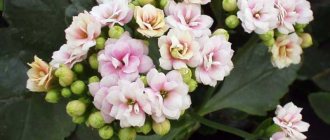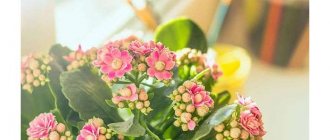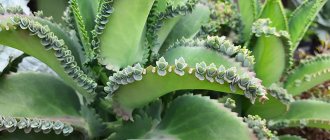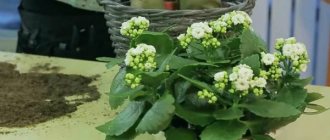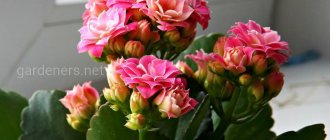Features of the plant
All types of Kalanchoe have common characteristics. Because succulents grow in the hot climates of Africa, Asia and South America, their leaves are adapted to store moisture and resemble thick pads. It is not for nothing that the family to which all Kalanchoe plants belong is called Crassulaceae.
Representatives of different species and varieties differ significantly from each other.
If Kalanchoe in a pot, as a rule, is a herbaceous plant or a small shrub, about 20 cm high, then in nature representatives of this family can grow up to two meters. The Kalanchoe flower can be red, yellow, orange, white, purple, pink, and vary in shape and size.
All are united by common features characteristic of Kalanchoe:
- fibrous, well-developed root system located in the top layer of soil;
- the stems are dense, juicy, completely covered with leaves;
- the fleshy leaves are dark in color;
- four-membered flowers are collected in panicle inflorescences.
Flowers can be erect or drooping, such as those of Kalanchoe mangina.
The flower of this type of Kalanchoe even in the photo looks fascinating. It is not surprising that this ampelous indoor plant is popular and loved among gardeners.
Types and varieties of Kalanchoe
Kalanchoe flowers of different varieties differ greatly from each other in shape, size and color. Most decorative varieties of Kalanchoe are bred through selective breeding, which makes it easier to keep in the house and ensures long-term flowering.
Kalanchoe Benta
A subshrub that is cultivated in cold greenhouses. Grows up to a meter tall. Large rounded leaves resemble thick needles and grow up to 40 cm in length. The flowers are white, with a tube at the base of the corolla.
Feathery Kalanchoe (kalanchoe pinnata)
In nature, pinnate grows more than a meter in height, has a thick stem and large leaves. Indoor flowers of Kalanchoe pinnate are much smaller than their wild relatives.
This variety is the most popular, it is familiar to many, it is used for medicinal purposes. On the serrated fleshy leaves, “babies” grow along the edge, with which the plant reproduces.
With proper care, the plant produces a long arrow on which pink flowers resembling bells bloom.
Kalanchoe daigremontianum
The Degremona variety is similar to the pinnate variety, with the only difference being that its leaves are rounded and not elongated.
Kalandiva
Indoor flower oxalis. Photos, names and signs
What kind of flower is this?
In my life I have never met a plant that had so many names: family happiness, hare cabbage, good morning, butterfly, triangular sorrel, flower of love, lucky clover. What kind of plant is this and why does it have so many names?
Let's start with the name "Butterfly". Its leaf really resembles this winged beauty, hence, apparently, the association. Why is wood sorrel triangular, and because each of its petals resembles a triangle? The plant is called “Good Morning” for its rare feature: in the evening it folds its leaves, and in the morning, waking up, it opens them. By the way, in nature, the Lucky Clover closes even in bad weather.
It is also notable for the fact that it blooms at home almost all year round without interruption. True, flowers lose in beauty to leaves, but they complement them with their contrast.
Surprisingly, “Hare Cabbage” can grow not only at home, but also in the garden. Even the wild nature suits her quite well, because the homeland of “Family Happiness” is Brazil and Mexico, although some species are found in Europe and Africa. Yes, and in our forests you can also find wood sorrel.
Why does the plant have such a strange name - sorrel, what does it mean? The fact is that the leaves of the flower contain a large amount of vitamin C and oxalic acid, so they taste sour, hence the name. In general, its scientific name is Oxalis, which means hot or sour.
Oxalis. Is it possible to keep a flower at home?
It is traditional to endow all plants with magical powers, both good and bad. Therefore, I hasten to answer the question: “Is it possible to keep an oxalis flower at home?”
The energy of sorrel is considered positive and very useful for the home - this plant is a talisman. It brings good luck, success in business, love, happiness and well-being in the family to the house, because it is not for nothing that it is called the flower of love and family happiness. If you have problems in your personal life, then bring him into the house and everything will work out.
In addition, sorrel is used for food and for treatment. It is used to treat wounds, ulcers and hypertension. Due to the large amount of vitamin C, this plant is used to improve immunity, as a choleretic and diuretic. However, the oxalis flower is poisonous, and therefore is considered dangerous to human health if consumed in large quantities. In small doses it is harmless. At one time my kitten tried to gnaw it, nothing, it still runs around.
What does an oxalis flower look like?
The plant has more than 800 varieties, but I will show you the most popular of them. This is what oxalis looks like.
Trifoliate violet
Four Leaf Deppe
Ordinary
Bovey
Multicolored
Ferruginous
How to care for Kalanchoe at home
Kalanchoe, which is quite easy to care for at home, has won people’s love and popularity for good reason. The main parameters that make up the care of Kalanchoe are: lighting, temperature and watering.
Since succulents grow in regions with hot climates, they need to maintain a microclimate close to natural. But it would be hard to call these indoor plants picky and capricious.
Bloom
How often Kalanchoe blooms depends on the conditions under which it is kept. By the whim of nature, Kalanchoe blooms in the autumn-winter period, when the air temperature is relatively low (at night about +70C, during the day - no higher than 150C), and daylight hours are short, 10 hours, no more. The plant blooms profusely on glassed-in loggias, but it is important not to overfreeze it: temperatures of +40C and below trigger irreversible processes in the leaves and stems and the flower dies.
To achieve year-round flowering, you will have to “lower” the air temperature and put the plant in the dark for 14 hours a day.
A freshly purchased flowering bush will not stop flowering if it is placed in partial shade and watered infrequently.
Faded buds need to be cut off, making room for new ones and preserving the aesthetic appearance of the Kalanchoe.
Oksalis is hot
Triangular oxalis tolerates the summer heat only outdoors. In room culture, it is better to limit the maximum temperature values to 25 degrees. If you keep the plant on a hot window or balcony, it can grow rapidly, followed by rapid flowering and drying out, or it can hardly grow, producing a few inconspicuous leaves.
Watering, and care in general, can compensate for hot conditions, but it is better to try to place the pots so that the soil in the containers does not overheat:
- place it lower, allowing the leaves to bathe in the light, and leaving the pot protected;
- moving plants to the background or lower only during sunny hours;
- by wrapping the container with additional protection (for example, a light-colored cloth) or placing it in an external decorative vessel.
Oxalis triangularis will help cope with the heat and increase air humidity - simple spraying, which can be done as often as possible. It is enough to make sure that the nozzle on the sprayer is “foggy” and does not leave large drops on the plant.
A cool winter, with a temperature of at least 12 degrees, is a desirable, but not mandatory, measure for triangular sorrel. This species will bloom even when wintering in temperatures above 18 degrees. Although coolness stimulates even more rapid growth and a larger number of flowers, in order to cause a complete lack of flowering, winter heat must also be “combined” with errors in care.
Spraying will help oxalis triangular to cope with the heat. © plant_wizard28
Living conditions depending on the season
The conditions of detention directly depend on what the owners want to get from the flower. If the goal is abundant flowering, then the Kalanchoe will have to be hidden in a dark room for one and a half to two months or covered with a dark film (simulating night) for 14 hours a day.
In addition, the air temperature should be close to autumn-winter (+7 at night and +15-16 during the day). Blooming Kalanchoe retains its appearance for several months in a row.
For the winter, the already rare watering is significantly reduced and fertilizing is not applied.
If there is no goal to achieve flowering, then the plant grows as usual, with the only difference being that the western or eastern window can be replaced with a southern one. Shoots that become very elongated due to insufficient winter light are pruned (Kalanchoe can be propagated with them).
Reproduction
There are several ways to propagate Kalanchoe: cuttings, leaves, seeds, “babies”, axillary buds and suckers.
Cuttings
Cuttings are one of the simplest and most popular methods of propagating succulents. Strong, healthy branches about 10 cm long are suitable for cuttings. The apical cuttings, pruned to give the bush a shape, take root well.
The lower leaves are removed from the cut shoot and the cut is cleaned.
- After 10-12 hours, the cuttings are rooted in soil for succulents, deepened by 2-3 cm, watered and left alone.
- The cuttings are placed in water or in a root growth solution (for a day), and then in water, in a warm, shady place. After the roots appear, the cuttings are planted in a pot with soil.
Leaves
Kalanchoe leaves root not only as well, but even better than cuttings. Fallen succulent leaves can be placed in a container with water, and when roots appear, transplanted into the ground. A fresh cut leaf easily takes root in the soil (it needs to be watered and covered with a jar or half a plastic bottle for 4-5 days).
Seeds
The seeds are scattered on the surface of the soil, without deepening them, lightly sprinkled with earth. Water with a thin stream of water, cover the container with a cloth or film and put it in a cool, shady place.
As soon as the sprouts hatch, they are picked and again covered with a transparent film with holes for air circulation. After several true leaves appear, the young shoots can be planted in pots.
Children
Some types of Kalanchoe form small outgrowths on the edges of the leaves, reminiscent of tiny leaves with roots - “babies”. Most often, the “babies” crumble into the ground when you touch the plant, germinate and produce young shoots, which are then replanted.
You can collect the “babies” and sow them in a separate pot for a permanent habitat.
Axillary buds
Axillary buds form in place of fallen leaves. They resemble a small head of cabbage and take root well when transplanted.
Offspring
Kalanchoe forms new shoots growing from the mother - offspring. When they reach 1/3 of the height of the main shoot, they can be transplanted into separate pots.
Growing seedlings
Seeds are planted for seedlings from late March to mid-April. After planting in cups or a greenhouse, after a while flower sprouts appear, which grow together and without much hassle. Their watering should be moderate, otherwise the roots may rot. It is desirable that the plant whose seedlings are grown is already formed in a glass.
Night beauty flower seeds must be buried in moist soil in a container or glass to a depth of 0.5 cm. After this, they should be covered with cellophane and placed in a warm place. After one and a half to two weeks, the first shoots will appear, after which the cups or containers should be placed in a warm and bright place. Good seedlings are the key to a beautiful and healthy plant. She won't cause much trouble. All she needs is watering, warmth and good light.
Diseases and pests
Diseases:
- Excessive air humidity and excessive watering can cause the appearance of gray, wet spots that destroy leaf tissue. This is gray rot, which needs to be combated with the help of special preparations, as well as drying the soil and air, placing the pot on the sunny side;
- at high air temperatures, powdery mildew may appear on the leaves - a white fine coating. It will be destroyed by treatment with fungicides, for example, foundationazole.
Pests:
- scale insects are dark tubercles that move along the stems and leaves, feeding on plant juices, causing tissue necrosis. Scale insects are removed mechanically, using a brush and laundry soap;
- In a similar way, you can deal with aphids, colonies of which leave a sticky sticky coating on the leaves, causing them to darken and dry out (drop).
Benefits and harms
From wood sorrel you can make a seasoning that is added to soups, vegetables, cereals or meat.
In folk medicine, all parts of horned wood sorrel are used - flowers, peduncles and leaves. They are collected in spring or early summer, and then dried at a temperature of +40-50 degrees.
Prepared decoctions are prescribed for the treatment of scurvy, stomach and liver diseases. Serves as an excellent antiseptic . The juice can be used to treat scabies.
At the same time, taking it in large quantities is harmful - accumulated oxalic acid can negatively affect the kidneys and urinary system. It should also not be used by people with joint diseases.
Care errors
The main mistakes that novice gardeners make:
- if the leaves lighten or turn red (depending on the variety), the turgor decreases - the plant receives too much light, it needs to be removed to partial shade;
- Kalanchoe does not bloom - the air temperature is too high, the daylight hours are long;
- leaves fall off - there is a heating source nearby, too dry hot air;
- Weeping spots and plaque appear on the leaves - the plant is infected with a disease; treatment with special preparations is necessary.
The main mistakes are too much light, water, heat, Kalanchoe does not like all this. It is better to put the pot in partial shade, reduce daylight hours and keep the temperature no higher than +180C. Water only when the soil is dry, with cool water, without touching the leaves.
Ignoring the light dependence of wood sorrel
Most often, triangular sorrel does not bloom due to the fact that it does not like the lighting. Experiments, rearrangements, and search for the optimal place are easy to carry out with it: leaves and growth rates quickly signal whether the plant is comfortable or not.
Direct sun at midday leaves unsightly burns on the leaves of the plant. But while other wood sorrel trees remain true sun-worshippers, triangular wood sorrel grows well in partial shade, although its colors may fade a little because of this. You should not make the shading strong: if the sorrel tree does not bloom, you should suspect insufficient lighting.
Eastern window sills are the best guide in choosing a location. In the western part, the plant is partially shaded in the afternoon; in the southern part, it is placed a little further in the interior or with a permanent scattering screen. But in the north, the plant may suffer from lack of light.
Folk signs
It is believed that a blooming Kalanchoe attracts good luck and prosperity to the home. The “babies” along the edges of the leaves resemble coins, and the abundance of flowers is associated with wealth.
In addition, it is believed that Kalanchoe makes the atmosphere in the house healthier. It “establishes” relationships between household members, and attracts couples to single people. The better the pet feels, the greater luck awaits its owner.

